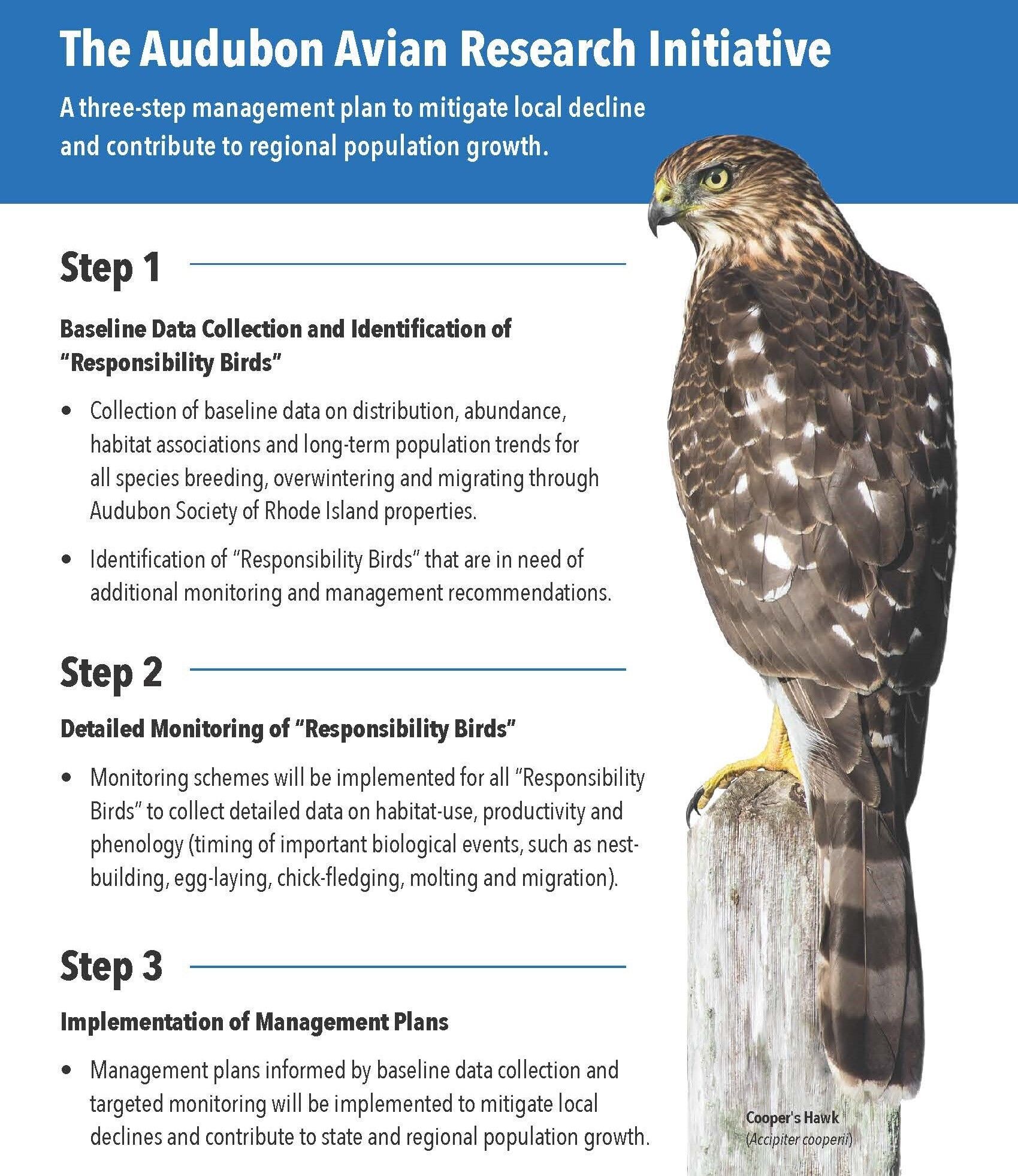Published March 7, 2023
It's Our Responsibility
The State of Our Birds: nearly every group of birds is declining. Audubon is working to bring them back.
By Betsy Sherman Walker
Audubon’s inaugural Regional Conservation Symposium, held on Saturday, January 28 at the Nature Center and Aquarium in Bristol, drew over 100 participants—scientists, the public, and passionate birders—from around New England. Spear-heading the event was a welcome from Dr. Charles Clarkson, Audubon’s Director of Avian Research, and the debut of the 97-page report, “The State of Our Birds”—a year-long undertaking involving more than 80 volunteers who ventured out to collect data and monitor birds in the countless nooks and crannies of Audubon’s wild refuges. The Symposium was an opportunity for colleagues from neighboring states to present their corresponding (and corroborating) research on the causes and effects of the alarming decline—close to 50% in some regions—in the bird population in the past 50 years.
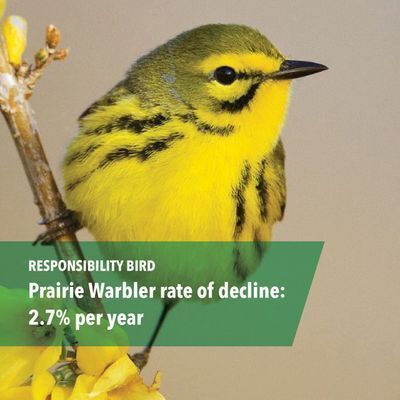
Audubon has identified nine common bird species that are still relatively abundant but have declined in numbers. These species are being called “Responsibility Birds” because it is crucial that we begin to address their decline now and work to manage and acquire habitat for their survival.
*Rate of decline for the past 50 years.
It was not so much a symposium as it was a communion—a chorus—of committed scientists. In his opening remarks about the report, Clarkson began with a nod to the 2020 Audubon Strategic Plan and its mission of getting the message out. One of the goals of the initiative, he said, was to create a “holistic picture” of the birds based on their use of Audubon’s Refuges. He explained the three-tiered approach—collecting data, monitoring species, and implementing management plans—and spoke in birding parlance of bird guilds, umbrella species, and responsibility birds. He also promised that this was just the first step, and that on the data front there would be more to come. He also urged those in the room, if not bird activists, to begin to advocate.
“After today,” he told them, “you can go forth and become better stewards.”
From Clarkson, the torch was passed to keynote speaker Dr. Chris Elphick from the University of Connecticut, who presented the research on the SHARP project (Saltmarsh Habitat & Avian Research Program.) Elphick and his team have studied the impact of sea level rise, tidal flooding and development on saltmarsh birds for years. He noted that the Saltmarsh Sparrow population had declined by 75% in the past twenty years. “That is a decline of around nine percent each year,” he explained.
“Think of what it would be like for you,” he said, “if your stock portfolio declined at nine percent a year.”
Other speakers offered their own research, and similar conclusions. No one came expecting a debate. “Around here you’re talking to the choir,” said Pam Hunt, Biodiversity Coordinator at New Hampshire Audubon. Hunt said that in the Granite State some species were half as common as they were fifty years ago. The biggest threat to them all she said, is development.
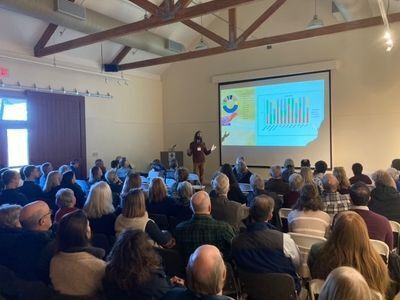
But even with all the sobering data presented at the symposium, there is no end to Clarkson’s reservoir of hope. Earlier in January, he had walked the wooded loops of the Powder Mill Ledges Wildlife Refuge in Smithfield, with this writer in tow. As he walked, he talked. He discussed the recently completed first year of the Avian Research Initiative, looked ahead to the symposium, and bravely peered into the great beyond: how to manage the data collected, how to implement the findings, and how to effectively communicate the message.
Clarkson touched upon the irrefutable facts. There has been a precipitous decline in the local bird population in Rhode Island and across the globe, brought on by the devastating impacts of climate change on what birds need to breed and thrive.
In the midst of all these unsettling data, Clarkson manages to see the glass as half-full. For him an alarming statistic represents something into which he can sink his teeth. “We are wading through the muck,” he said towards the end of the walkabout, “to find out the things we can do.” He elaborated. “I came into the position knowing things were not good, they haven’t been good for quite some time” he said. “But hope is essential. This doesn’t work if we don’t have hope.”
Prior to becoming involved in the Initiative, Clarkson served on the Audubon Board of Directors. Among his fellow board members was Jameson Chace, Associate Professor of Biology and Chair of Cultural, Environmental and Global Studies at Salve Regina University in Newport. Chace was among the presenters at the Symposium. From his perspective, he saw it as a success for two reasons. It was an opportunity to bring people together to focus on the local bird population. “You [rarely] get people in a room talking about southern New England birds,” he said. “All the right people were in the room that day.”
The second reason is the chance it gave the organization to step up and present Clarkson’s report as a model of research and data management. “Audubon is arguably the leading environmental organization in the state, in size and longevity,” Chace said. “It plays a pivotal role in promoting human interaction with the environment.” The strength of the Initiative as a research piece to be shared—“exported” was his word—places Audubon in the same orbit as the other New England conservation organizations. “We needed to get back out in front,” he added.
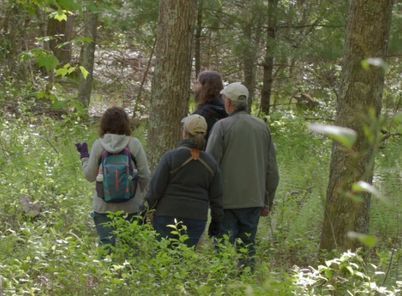
Dr. Charles Clarkson in the forest with volunteers | Source: Art, Inc./Tracy MacDonald
To get the muck to reveal its secrets, Clarkson and an army of more than 80 volunteers and other trained ornithologists spent the better part of a year performing crucial tasks. From the volunteers, he says he obtained invaluable “citizens’ science data from passionate birdwatch-ers.” Exhaustively studied were “142 point counts (each visited twice) across the fourteen wildlife refuges—during peak periods of detectability, night and day, at the height of the breeding season and at the height of overwintering.” When out on the trails, Clarkson said that he records “every single bird I hear, the total number of birds I see,” with which he compares habitat variables. The habitat data allows him to, “zero in on a species’ most important habitat.”
From the start, the decline in the bird population (a reveal from multiple international studies) was a given. From there, the Audubon initiative was launched as a “fact finding mission, to go in and find out more about how to help species in decline.” Factors included “habitat loss, climate change, window strikes—the number of bird stressors is astronomically high.”
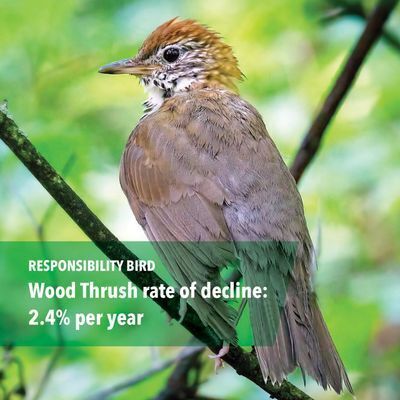
“We wanted to create a holistic picture on a per-species basis,” he explained. Ultimately, to allow the birds to speak for themselves. “To find out exactly what it is they are honing in on,” he added. Baseline data collected during that year also included information gathered by ARUs, or Acoustic Recording Units (placed in three selected Audubon habitats to follow activity during spring migration and breeding season.) “It is imperative,” he wrote in an earlier Report, “that we also understand whether habitats that birds rely on are themselves degraded.”
Another goal was to determine how many species are using Audubon’s refuges, why, and when—a valuable first step towards developing a management plan. He uses as an example the Common Yellowthroat, which is not listed as a national species of concern. “It’s a large population,” he explained. “Yellowthroats are found across huge swaths of North America, but are declining across much of this range. From coastal Virginia to coastal Massachusetts, there has been a decline of 1.5 percent per year for the last 50 years. Just because it’s not yet recognized on a state or federal scale,” Clarkson explains, “it doesn’t mean it shouldn’t be.”
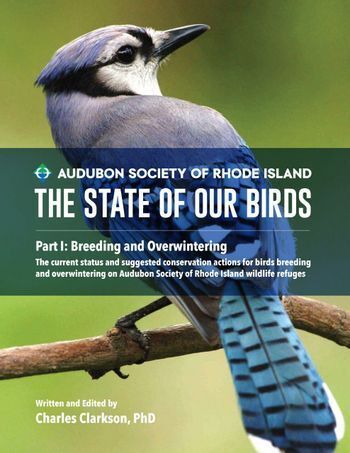
The State of Our Birds - Part 1: Breeding and Overwintering – Learn more at asri.org/AvianResearchInitiative
The new Audubon “State of Our Birds” report, he said, “tells us what we have—what habitats birds associate with and helps us identify our responsibility birds.” Nine species have been selected as “Responsibility Birds” because it is crucial to begin to address their decline now, and work to manage and acquire habitat for their survival.
If there were any surprises from his first year of research, they were hidden in plain sight. The numbers, almost everywhere, were off—worse than anticipated, even for such stalwarts as the American Robin, the Blue Jay, Common Yellowthroats, and Common Grackles. The Grackle is declining at an annual rate of more than two percent. “We need to acknowledge that some species of migrants have 90 percent of their global breeding population in the Northeast, and it’s our responsibility to ensure that conditions never get to the point where we have to be reactive in our conservation. We shouldn’t wait until things get worse than they already are.” Clarkson explains. “There are now so many sources of decline—there’s no longer a single silver bullet for conservationists anymore.”
Clarkson’s mission is to sound the alarm without sounding alarming. With the first year of research and analytics done (for now—the data gathering never stops), he is now focusing on once again trying to communicate their needs. “More people need to be connected to wildlife species,” he said. “Humans are so isolated,” he said, far removed “from the ebb and flow of nature.”
A chasm exists between the work that scientists do to better understand climate change and its effects on wildlife populations and the communication of this information to the general public. A major goal of the recently completed strategic plan at Audubon is to more effectively communicate these important issues to the citizens of our state. Conservation is a collective issue and we need more people to understand the drivers of declines in bird populations and become ambassadors for our wildlife. The recent science symposium hosted by Audubon at its Nature Center in Bristol and the Report itself are designed to facilitate the exchange of this information in an easily digestible format that is accessible to all.
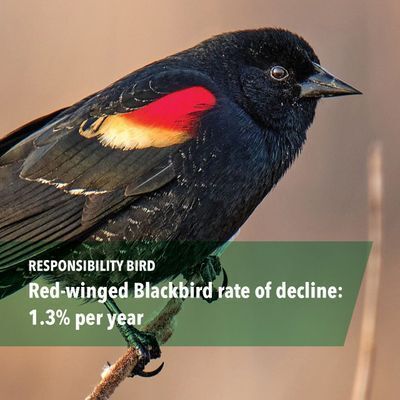
Chace also said that its reach beyond Rhode Island is key. “Hopefully,” he said, “we can export this and cooperate with entities in other states.”
And at the end, Clarkson remains realistically optimistic. “We want to maximize the good we are doing,” he said. His original goals for the January 28 Symposium were to create a conversation—a loud, boisterous, and substantive conversation, a productive sharing of ideas so the volunteers, public in attendance, and contributing scientists can go home and be better stewards for the birds. “I wanted the audience to come and learn all about the science and the species and to walk away with a better understanding of what we are witnessing.” The Symposium was a sold-out event with presenters coming from throughout New England. “I don’t want our work to be insular,” he explained. “Conservation is a global issue.”
Clarkson is also honing in on a management plan for the beleaguered bird populations utilizing Audubon’s properties. He saw the January 28 symposium not as the end, but as the start of the next level of inquiry, using the knowledge gained. “It’s a form of power. Knowledge is power,” he said. “If you can get people to feel more empowered, they will act.” Conservation, he added, “is a lengthy process. Stopping the decline is not going to happen overnight. I sincerely hope there are enough people open to receive the messaging.”
And if—and when—that happens, he believes, “more is possible.”
*Rate of decline for the past 50 years.
Betsy Sherman Walker is a Rhode Island native who writes for area non-profits, news, and lifestyle publications, and who has recently discovered the joy and wonder of birding. Touch base at walkerbets@gmail.com.

